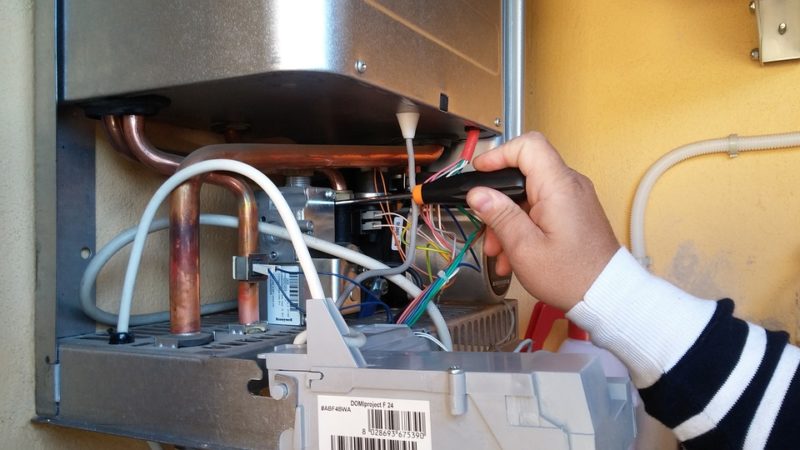How to clean a water heater? Follow the ways to prepare the device, open the faucet at home, get the hose connected to the tank’s drain valve, and open a drain valve.
In contrast, the tank is left empty, activates the cold water supply again, shuts the valve off, and gets the water heater back to its normal state. The water heater will last for ten years with proper cleaning and maintenance.
Learning to clean the device properly is the primary key to achieving this. In this article, you’ll get a run-through in the process of cleaning the water heater no matter what the type may be.
Steps To Clean A Water Heater
Learn how to clean a water heater by following the proper steps below.
Step #1. Preparing the water heater as it flushes
Switch the thermostat of the water heater off. Switch it to its “pilot” mode to save trouble from reactivating a pilot light. Follow this easy step so you won’t switch its gas off. In an electric water heater, cut the power in the unit with the right switch. Afterward, turn a cold water supply off with a valve found on top of the heater.
Step #2. Opening the faucet for hot water in the home
Drain the water heater tank as you open the tap for hot water. Follow the step to avoid a vacuum forming and let water flow in the tank; this seems like a weird physics impact, same as the water that stays in the straw, as you maintain a finger above. I guess it’s helpful to read about how to clean hot water heater.
Step #3. Getting the hose connected to a drain valve of a tank
Search for a drain valve right next to the underneath of a tank. You want the hose to continue outside or an enormous container, and away from the foundation of a home. A bucket is never giant enough that you’ll face flooding in the basement. A drain in the basement allows placing the end of the hose next to, while guiding water there. Know how to drain a hot water heater.
Step #4. Opening a drain valve to allow emptying the tank
Please observe that the chunks expel depending on the sediment accumulated inside the tank. Clean the tank regularly, and you’ll measure your consistency following the number of deposits coming out. And if no water flows from the tank upon opening a drain valve, it’s a sign of sediment build-up. It has already clogged the tank and the drain valve. Remedy this by using a wet and dry shop vacuum that dislodges the blockage, this does the trick, but it doesn’t; ask for expert attention.
Step #5. Re-activating the supply of cold water
Re-activate the cold water supply before you disconnect a hose from a drain valve. The water dislodges the extra sediment that stays still inside the tank. Allow the drain valve to run for several minutes; you see the water is clear as it comes out of a hose. Turn on the supply of cold water once more.
Step #6. Shutting a drain valve off
Shut a drain valve off after removing its garden hose and turning the cold water supply back on.
Step #7. Closing the faucets for like a minute
If the water heater tank refills, discolored water often flows out from the faucet. After several minutes, the notice clears up already. If this ever happens, securely close the taps.
Step #8. Returning the water heater to its usual state
Set the thermostat to its normal state, as you also re-light the pilot light after opting to switch it off. Switch the electricity back on if you utilize an electrical water heater.
Clean The Water Heater Using A Vinegar
If the water heater is with sediment, it is better to use vinegar that cuts through it. The process demands several steps as follows.
Step #1. Removing an anode rod
Refer back to the manual instructions of the tank for the process. Unfasten the recessed bolt with a wrench.
Step #2. Using funnel in placing the vinegar in a tank
A hole is what you see in the place after removing an anode rod. Place the funnel next and pour not more than 4-vinegar gallons into the funnel and the tank.
Step #3. Replacing an anode rod while activating the supply of cold water
Install an anode rod again and switch the supply of cold water. Doing so causes a refill in the tank, allowing it with this vinegar water for twenty-four hours. The acidity of the vinegar works to eat the sediment away. Know how to replace anode rod in water heater.
Step #4. Completing the draining, including flushing
The process of draining and flushing must complete as outlined. Remove the sediment and the vinegar inside the tank.
It’s A Wrap!
You already know how to clean a water heater. You need to follow the steps carefully. And if you want to move more sediment away, vinegar makes an effective tool to use. Complete the draining, including the flushing, and the water heater is good-to-go. You’ll be surprised that the water heater lasts for years!

